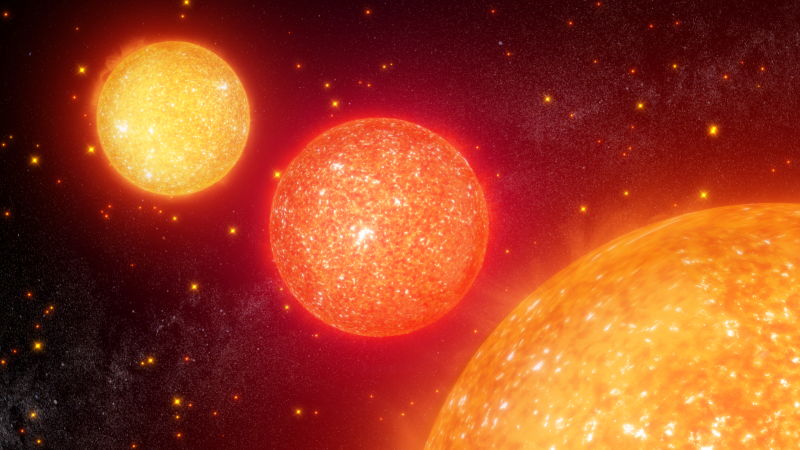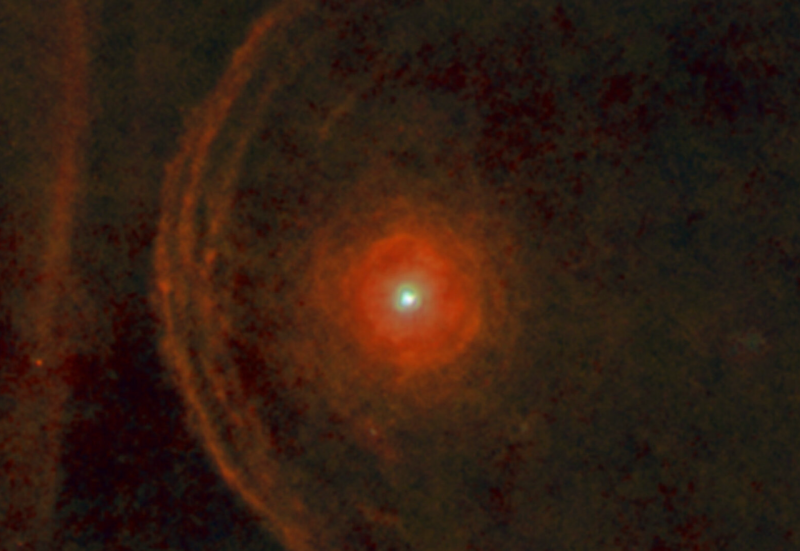
What are red giants?
A red giant is a star in its death stages. It has slowly swollen up to many times its original size. Once at the red giant stage, a star might stay that way for up to a billion years. Then the star will slowly contract and cool to become a white dwarf: Earth-sized, ultra-dense star corpses radiating a tiny fraction of their original energy. Eventually, after billions of years, these stars will become totally cold and radiate no energy. They’ll end their lives as a so-called black dwarf: a tiny, burned-out, virtually-invisible cinder.
To become a red giant, a particular star must have between half our sun’s mass, and eight times our times our sun’s mass. Astronomers call such stars low- or intermediate-mass stars. So you can see that our sun is one of the stars that will inevitably, someday, become a red giant.
So it’s our sun’s destiny to become a red giant star (and afterwards a white dwarf, and then a black dwarf). But what processes will drive the sun’s evolution to the red giant stage? And what will happen exactly, inside the star, as it changes? Let’s examine the fate of low- or intermediate-mass stars such as our sun, as they evolve to the red giant phase.

Hydrogen: A star’s 1st fuel
Stars radiate energy by converting hydrogen to helium via nuclear fusion. It’s this process that causes our sun to radiate light, heat and other forms of energy as a byproduct. But nuclear fusion in stars at first requires hydrogen. And stars don’t have an infinite supply of hydrogen. Our sun converts around 600 million tons of hydrogen into helium every second. If that sounds as if the supply should therefore soon exhaust itself, just remember that the sun is a star nearly a million miles across. And if you have trouble visualizing that, imagine boarding a jet airliner for a flight that is going to last 226 days. That is how long it would take you to fly around our local star.
In truth, our sun, as an average star of its type, was born with enough hydrogen to last for around 10 billion years. Astronomers estimate our star is now around 4.5 billion years old. So the sun is leaving the halcyon days of its youth behind it. It’s entering into middle age. And like people, it won’t be too long until its processes start to change and falter.
Hydrogen burning and the main sequence
We call the current stage of our star’s life the hydrogen-burning phase, because its energy source is the fusion of hydrogen atoms. But burning is a bit of a misnomer. It’s nuclear fusion, not chemical burning. Stars do not burn in the conventional sense of the word. Still, astronomers do use the term burning to describe the type of fusion going on inside a star. Hence, you might hear of carbon burning or helium burning. Both are stages of nuclear fusion, consuming different elements, when a star nears the end of its life.
Stars that mostly burn hydrogen are in what’s known as the main-sequence phase. As a main sequence star, our sun is in what’s called stellar equilibrium. That means the outward radiation pressure from the sun’s internal fusion reactions exactly balances the inward push of the sun’s own gravity.
It’s important to realize that, when the sun’s on the main sequence, even the consumption of hundreds of millions of tons of hydrogen per second does not immediately deplete the sun’s hydrogen. Only 0.7% of our sun’s hydrogen consumed in the fusion process will ultimately be radiated as energy. The rest is used up converting the hydrogen atomic nuclei into helium atoms. That tiny percentage of energy has been giving us all the light and heat we get from the sun for the last 4.5 billion years!
Read more about this video: An all-sky red giant star symphony
The star begins to die
Eventually, as its nuclear fires falter, a star starts to contract under its own gravity. At the same time the star is shrinking, its temperature is increasing. So the star becomes brighter.
In an aging star, this phase of shrinking and brightening can last for several million years. The shrinking core, which is heating up as it shrinks under gravity, brings more hydrogen towards the center of the star, into the place previously occupied by the now-shrunken core. Eventually, temperatures and pressures are sufficient to ignite this shell of hydrogen around the core: radiation from this new hydrogen-shell burning pushes outward through the star, causing its outer layers to expand. There are complex physical processes at work here, but the laws of the conservation of energy, in conjunction with the way gravity behaves, mean that if the core of the star shrinks, the rest of the star must expand. The star has started evolving into what is known as a subgiant star, representing an intermediate phase between the main sequence and the red giant stage.
It becomes a red giant
The hydrogen-shell burning occurs through fusion processes that are far more intense than they were when the star was on the main sequence. The result is that the star brightens by a modest amount. But the outer layers of the expanding star, now being further away from the hydrogen shell around the core, cool at the same time, dropping from a maximum of between 6,000 and 30,000 degrees down to 5,000. This also means that the star’s light reddens, in the same way that a cooling poker removed from a fire will cool from white through yellow to red over time.
The hydrogen-burning phase can last for between a few hundred million to a billion years, depending on the initial mass of the star. For stars between 0.8 and 2 times the mass of our sun, this results in a subgiant which is 10 times the diameter of our sun. Stars of mass outside this range may then follow different evolutionary paths, but for a star like the sun the next phase will be a massive increase in size, a huge rise in brightness and more cooling. The driving energy for this will arise from the helium core, collapsing, getting denser until, at the end of the subgiant phase, it becomes hot enough to burn its helium. This causes a large increase of energy output which forces the expansion of the star. Eventually, after perhaps hundreds of millions of years, the star will be a hundred times the diameter of the sun and distinctly red in color.
And so a red giant is born.
A star will be in the red giant phase for typically around a billion years. What happens next will depend on the star’s mass. High-mass stars will explode as supernovae. Low- to intermediate-mass stars like our sun will slowly shrink and cool into white dwarf stars.

In the night sky
We can look up and see several red giants with our unaided eyes. Aldebaran and Antares are just two examples. But perhaps the most famous is Betelgeuse, in the constellation of Orion. It’s famous because it hit the headlines a little while ago when it suddenly started getting dimmer, over a period which lasted for several months in 2019. Its brightness dropped by more than 60%, meaning it was noticeably dimmer in the night sky. Read more about Betelgeuse’s extraordinary dimming.
So what of our sun? Over the next few hundred million years, it will slowly increase in brightness and start to radiate more energy across the electromagnetic spectrum, as it heads towards its subgiant phase. That’s bad news for the Earth. In about a billion years, increasing radiation from our star will have sterilized our planet, extinguishing all life.
Eventually, as our sun completes its changes from a modest G-type star into a red giant, it will expand to swallow Mercury, Venus and perhaps Earth too. And that will be the end of our world.
The study of red giants is complex, as there are many variables and exceptions. It can throw out the unexpected, like the dimming of Betelgeuse. But these giant stars are just going through a natural phase of life, getting old and dying. By the time our sun, for example, ends its life as a white dwarf, it will have lived for ten billion years. And perhaps, when our star swells up to enormous size, it will be studied by alien civilizations looking from afar, as we study Betelgeuse and the other giants in our skies. They will have little idea that, once, a tiny blue dot orbited that star, whose inhabitants looked to the stars and wondered, too.
Bottom line: What are red giants? Most main sequence stars, like our sun, will become one. Red giants swell to such a large size they can swallow their inner planets.
The post What are red giants? first appeared on EarthSky.
0 Commentaires